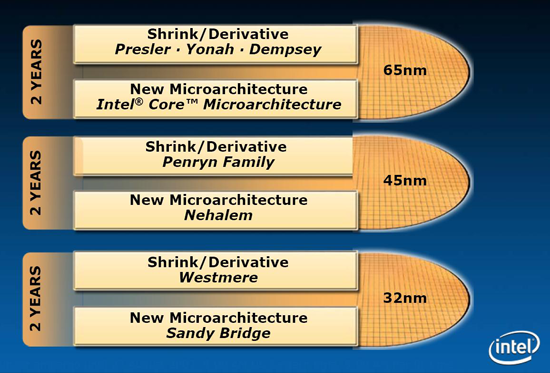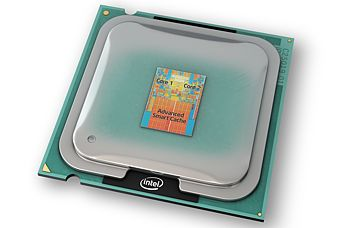Intel's 45nm Dual-Core E8500: The Best Just Got Better
by Kris Boughton on March 5, 2008 3:00 AM EST- Posted in
- CPUs
What's the next best thing to an Intel 45nm quad-core processor? Why, a 45nm dual-core, of course. At least that's what Intel seems to being saying lately. While we tend to agree, there are certainly more than a few important considerations to take into account when deciding just which CPU is best suited for your intended uses. Choosing a CPU can be as personal an experience as buying a new car. While you know what you want, it really comes down to what you need, what you can afford, and more importantly, what makes sense. Although the four-core model easily overclocked to 4GHz or higher on air alone certainly does sound sexy, the brown sub-compact in the corner of the lot may be just what you're looking for. Don't worry though; either way Intel has an answer for you….

Intel's "tick-tock" strategy gives us a very early glimpse at the future of micro processing. If all goes well, Moore's Law should be as true in 2010 as it is today…
Amid rumors of manufacturing problems, the next step in the continuation of Intel's accelerated "tick-tock" strategy - which pledges process-technology shrinks of existing designs and the introduction of entirely new core architectures on an alternating two-year cycle - comes the release of a new line of 45nm dual-core processors, codenamed Wolfdale. Built on the familiar Core 2 architecture, these processors feature a few notable changes with some rather large implications for the overclocking crowd, all of which we will discuss in more detail later. For starters, advancements in process technology have allowed Intel to shrink the size of the transistors used in these CPUs from last-generation's 65nm down to 45nm, allowing for a ~50% reduction in die size for an equivalent design.
The changes don't end there; a few core processing modification have been made, making Wolfdale a little faster clock-for-clock than Conroe. These changes include but are not limited to: a new divider technique called Radix 16 that nearly doubles the speed of operations involving operand division, the introduction of 47 new Intel Streaming SIMD Extensions 4 (SSE4) instructions (many perfect for HD video production and decoding), and a unique 128-bit wide Super Shuffle Engine that significantly improves performance for all SSE-related instructions (i.e. content creation, image manipulation, and video encoding). Unfortunately, it will take some time for software developers to catch up with most of these innovations, but eventually we should see more and more programs and games that show the true power of these feature sets.

The layout of discrete components on the bottom of any Intel CPU is an easy way to quickly determine which product series you hold in your hands. This is what a 45nm E8000-series dual-core looks like.
Finally, the L2 cache size has been substantially increased. The E8000-series processors will feature up to 6MB of shared L2 cache, up from 4MB per core pair. However, the larger L2 cache comes with a move from the previous low-latency 4MB 8-way association scheme to a more complicated 24-way associated cache when using 6MB, adding precious nanoseconds to each data fetch. The larger cache is technically "better", but the higher latencies will in some cases negate the benefit, so this is not a clear improvement in 100% of cases. There has been no formal word yet from Intel as to whether this trade-off was a result of the use of the larger cache or if it was an intended design change.
All 45nm dual-core Intel CPUs will operate at a default bus speed of 333MHz (1333 quad-pumped), which is needed in order to give the included store forward technology and intelligent prefetch algorithms the fast memory access they desire. These background processes, combined with the use of the large L2 cache, are instrumental in Intel's recent success in hiding most of the traditional memory access latency experienced with many older designs. Although memory access operations are still slower than desired, more cache means these processes are able to look farther ahead, fetch more data into the L2, and increase the chances that an incorrect branch assumption will not result in a costly data stall. The move to an integrated memory controller (IMC), like that in Nehalem planned for a Q4 2008 release, will largely invalidate the necessity of these super-scalar caches.

The Intel Core 2 Duo E8500 processor promises to be the fastest, most energy efficient dual-core CPU ever designed for the PC.
We have noted in previous articles what an amazing difference Intel's new high-K 45nm process has made in the improved switching efficiency and the reduction in leakage current of these tiny transistors. Our results with the Core 2 Extreme QX9650 were nothing short of impressive. First impressions left us feeling as though Intel had either made a mistake in calculating the processor's thermal characteristics, or more likely they decided to conservatively rate these new quad-cores relative to the older 65nm quad-core CPUs. In any case, the improvement was real and measurable.
Drawing upon that same success, the E8000-series of dual-core processors shows great promise when applied in situations that demand unrivaled performance and/or energy-efficient operation. While there is no doubt that the E8500 will excel when subjected to even the most intense processing loads, underclocked and undervolted it's hard to find a better suited Home Theater PC (HTPC) processor. For this reason alone we predict the E8200 (2.66GHz) and E8300 (2.83GHz) processors will become some of the most popular choices ever when it comes to building your next HTPC.
What's more, Intel has decided to stay with the classic LGA775 package for at least one more round, meaning there is a good chance an upgrade to one of these new 45nm processors could be easier than you originally thought it would be. Past upgrades have required the purchase of an entirely new motherboard due to modifications to the Voltage Regulation Module (VRM) specifications, dictating board-level hardware changes needed for new processor compatibility. Not so with Wolfdale; a simple micro-code BIOS update from your motherboard vendor is often all that is necessary to add official support for these CPUs. After that, it's only a matter of removing the old processor and installing the new one, and you can begin enjoying all the benefits an E8000-series processor has to offer.










45 Comments
View All Comments
chizow - Wednesday, March 5, 2008 - link
Only had an issue with this statement:While this may be true for those building a new system around a new CPU, this might not hold true for those looking to overclock using an existing board. These 45nm CPUs with their higher stock 1333 FSB will by necessity use lower multipliers which essentially eats into potential FSB overclocks on FSB-limited chipsets. Considering many 6-series NV chipsets and boards will not support Penryn *at all* this is a very real consideration for those looking to upgrade to something faster.
Given my experiences with NV 6-series chipsets compared to reviews, I'm not overly optimistic about Penryn results on the 7-series either. Curious as to which board you tested these 45nm with? I haven't kept up with P35/X38 capabilities but the SS you showed had you dropping the multiplier which is a feature I thought was limited to NV chipsets? I might have missed it in the article, but clarification would be appreciated.
TheJian - Thursday, March 6, 2008 - link
I have a problem with this part of that statement "Intel has also worked hard to make all of this performance affordable." They forget it was AMD who forced Intel to cut margins on cpus from 62% (I think that was their high a few years back) to a meager 48% (if memory serves) and their profits to tank 60% in some quarters while driving AMD into the ground. Do they think they were doing it for our sakes? NOT. It was to kill AMD (and it worked). WE just got LUCKY.How much INTEL butt kissing can you do in one article? Notice that since AMD has sucked Intel is starting to make an ABOUT FACE on pricing. Server chips saw an increase of 20% about a month ago or so (it was written about everywhere). Now we see the E8400 which was $209 on newegg just a few weeks ago and IN STOCK, is said to go for $250 if you believe Anandtech. Even newegg has their future chips when they come back in stock now priced at $239. That's a $30 increase! What is that 14% or so? I missed the first E8400's and thought it would go down, instead Intel restricts volume and causes a price hike to soak us since AMD sucks now. I hope AMD puts out a decent chip shortly (phenom 3ghz would be a good start) so we can stop the price hikes.
What's funny to me is the reviewers let Intel get away with pricing in a review that comes nowhere near what it ACTUALLY debuts for. They've done the same for Nvidia also (not just anand, but others as well). The cards always end up being $50 more than MSRP. Which screws competitors because we all wait for said cheap cpu/gpu and end up not buying a very good alternative at the time (on the basis of false pricing from Intel/Nvidia). They should just start saying in reviews, "but expect $50 more upon debut than they say because they always LIE to get you to not buy the competitors product". That would at least be more accurate. For the record I just bought an 8800GT and will buy a wolfdate in a few weeks :) My problem here is the reviewers not calling them out on this crap. Why is that?
mindless1 - Wednesday, March 5, 2008 - link
Yes you are right that the higher default FSB works against them, it would be better if a Pentium or Celeron 45nm started with lower FSB so the chipsets had enough headroom for good overclock.NV is not the only one that can drop the multiplier, I've not tried it on X38 but have on P35 and see no reason why a motherboard manufacturer would drop such a desirable feature unless the board simply was barren of o'c features, something with OEM limited bios perhaps.
Psynaut - Wednesday, March 5, 2008 - link
It took me a minute to figure out that they were talking about the chips that were released 6-8 weeks ago.squito - Wednesday, March 5, 2008 - link
Same here ... maybe they need to be reintroduced?Johnbear007 - Wednesday, March 5, 2008 - link
Where in the U.S. do you see a Q6600 for under 200$???? I still see it at 245$ at newegg and your own anandtechshopping search doesn't come anywhere near the pricepoint you mention.XtAzY - Wednesday, March 5, 2008 - link
If you take a look at Hot Deals last month, you could have gotten a q6700 for $80http://hardforum.com/showpost.php?p=1032017513&...">http://hardforum.com/showpost.php?p=1032017513&...
but of course it's already over
smithkt - Wednesday, March 5, 2008 - link
That was for the e6700 not the q6700firewolfsm - Wednesday, March 5, 2008 - link
With core 2s, you can always do a minor frequency overclock while actually undervolting it. With a decent cooler, it could even last longer than stock.ap90033 - Wednesday, March 5, 2008 - link
Is it me or was this a little to negative on the OC stuff? I mean really, if you have good cooling, keep the voltage 1.44 or lower I bet the CPU would last 2-3 years or more...It almost sounds like they are marketing for Intel, "Great Overclokcer" but wait dont OC just get the highest model or it will only last 10 minutes!